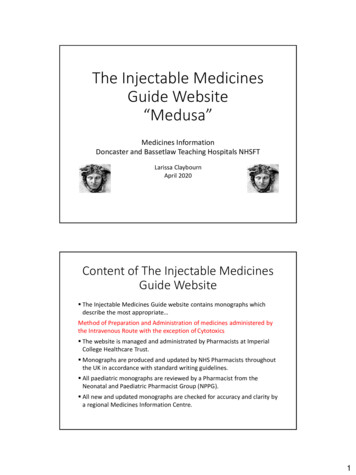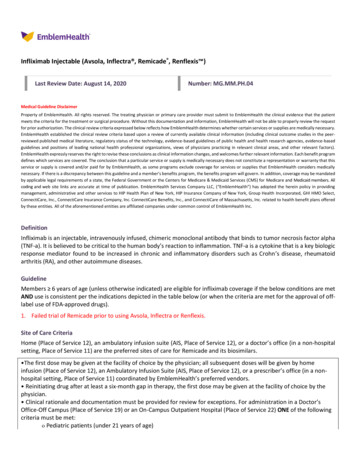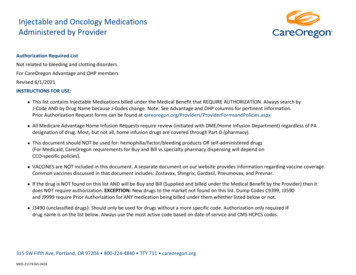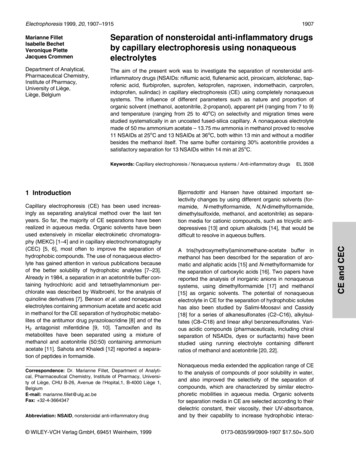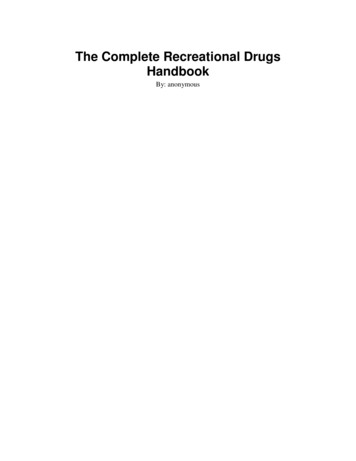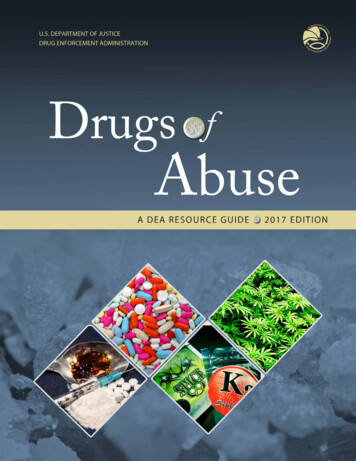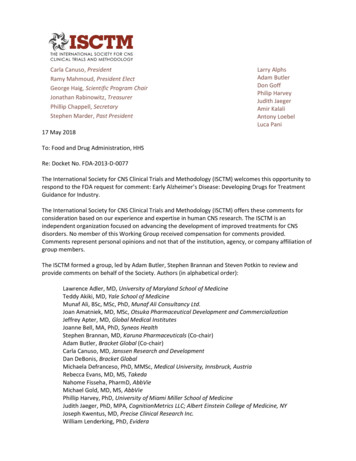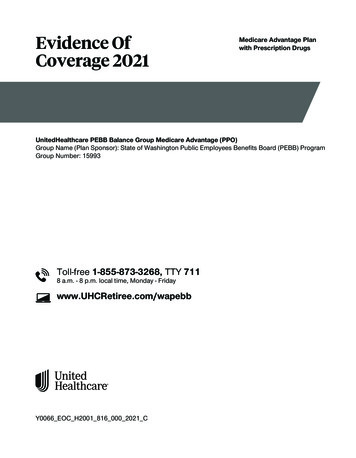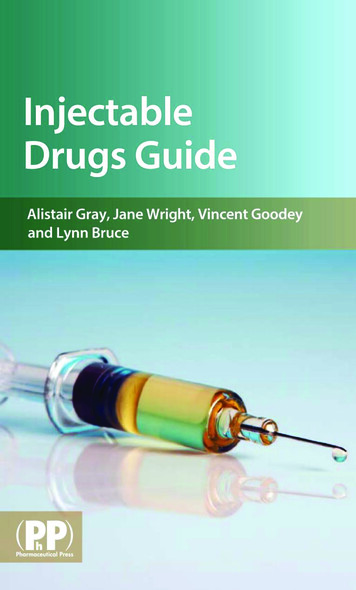
Transcription
Injectable Drugs Guide
Injectable Drugs GuideAlistair GrayBSc(Hons) MRPharmS DipClinPharmClinical Services Lead PharmacistEast Lancashire Hospitals NHS Trust, UKJane WrightBSc(Hons) MRPharmS DipClinPharmLead PharmacistLancashire Care NHS Foundation Trust, UKVincent GoodeyBSc(Hons) MRPharmS MScDeputy Director of PharmacyEast Lancashire Hospitals NHS Trust, UKLynn BruceBSc MRPharmS DipClinPharmPharmacy Team LeaderMedical Assessment Unit, Royal Blackburn HospitalEast Lancashire Hospitals NHS Trust, UK
Published by Pharmaceutical Press1 Lambeth High Street, London SE1 7JN, UK1559 St Paul Avenue, Gurnee, IL 60031, USAÓ Royal Pharmaceutical Society of Great Britain 2011is a trade mark of Pharmaceutical PressPharmaceutical Press is the publishing division of the Royal Pharmaceutical SocietyFirst published 2011Typeset by Thomson Digital, Noida, IndiaPrinted in Great Britain by TJ International, Padstow, CornwallISBN 978 0 85369 787 9All rights reserved. No part of this publication may be reproduced,stored in a retrieval system, or transmitted in any form or by any means,without the prior written permission of the copyright holder.The publisher makes no representation, express or implied, withregard to the accuracy of the information contained in this book andcannot accept any legal responsibility or liability for any errors oromissions that may be made.The right of Alistair Gray, Jane Wright, Vincent Goodey and Lynn Bruceto be identified as the authors of this work has been asserted by themin accordance with the Copyright, Designs and Patents Act, 1988.A catalogue record for this book is available from the British Library.
ContentsPrefaceHow to use the Injectable DrugsGuide monographsFeedbackAbout the Aciclovir (acyclovir)AdalimumabAdenosineAdrenaline llineAmiodarone hydrochlorideAmoxicillin (amoxycillin)Amphotericin (amphotericin B)AmpicillinAnidulafunginApomorphine hydrochlorideAripiprazoleAscorbic acid (vitamin C)AtenololAtosibanAtropine 4251555659616466697274Bemiparin sodiumBenzatropine mesilate(benztropine mesylate)Benzylpenicillin (penicillin userelinCalcitonin (salmon)CalcitriolCalcium chlorideCalcium folinate (calcium leucovorin)Calcium gluconateCalcium levofolinate(calcium ofunginCefotaximeCefradine mphenicolChlorphenamine maleateChlorpromazine hydrochlorideCiclosporin (cyclosporine, indamycinClodronate 24127130132136139142146148151155158161164167
vi ContentsClonazepamClonidine hydrochlorideCo-amoxiclavCodeine phosphateCo-fluampicilColistimethate sodiumCo-trimoxazoleCyanocobalamin (vitamin B12)CyclizineDalteparin sodiumDanaparoid sodiumDantrolene sodiumDaptomycinDesferrioxamine mesilateDesmopressin acetate (DDAVP)DexamethasoneDexrazoxaneDextran 70Diamorphine hydrochlorideDiazepam emulsionDiazepam solutionDiazoxideDiclofenac sodiumDicobalt edetateDigoxinDigoxin-specific antibodyfragmentsDihydrocodeine tartrateDimercaprolDipyridamoleDisodium folinate (sodium folinate)Disodium levofolinate(sodium levofolinate)DisopyramideDobutamineDopamine hydrochlorideDopexamine hydrochlorideDoripenemDoxapram hydrochlorideEnfuvirtideEnoxaparin sodiumEnoximoneEphedrine romycin lactobionateErythropoietinsEsmolol hydrochlorideEsomeprazoleEtanerceptEthanolamine oleateExenatideFentanylFilgrastimFlecainide acetateFlucloxacillin ntixol decanoateFolic acidFondaparinux sodiumFoscarnet sodiumFosphenytoin sodiumFurosemide (frusemide)GanciclovirGelatinGentamicinGlatiramer acetateGlucagonGlucose (dextrose monohydrate)Glyceryl trinitrateGlycopyrronium bromideGoserelinGranisetronGuanethidine monosulfateHaloperidolHaloperidol decanoateHartmann’s solution (sodiumlactate compound, Ringer-lactate)HeparinHyaluronidaseHydralazine hydrochlorideHydrocortisone acetateHydrocortisone sodium phosphateHydrocortisone sodium succinateHydroxocobalamin (vitamin B12)Hyoscine butylbromide(scopolamine butylbromide)Hyoscine hydrobromide(scopolamine hydrobromide)Ibandronic 408411414418420423425428431434436439
Contents viiIloprostImipenem with cilastatinInfliximabInsulinsIntralipidIron dextran (CosmoFer)Iron sucrose (Venofer)IsoniazidIsosorbide dinitrate (ISDN)ItraconazoleKetamineKetoprofenKetorolac trometamolLabetalol dinLeuprorelin acetateLevetiracetamLevocarnitine eprazine)Lidocaine (lignocaine)hydrochloride -- intravenousadministrationLidocaine (lignocaine)hydrochloride -- localanaesthetic useLinezolidLiothyronine sodium(L-tri-iodothyronine)LoraxepamMagnesium Methadone hydrochlorideMethylprednisolone acetateMethylprednisolonesodium succinateMetoclopramide hydrochlorideMetoprolol e hydrochlorideMicafunginMidazolamMilrinoneMorphine sulfateMorphine tartrate withcyclizine (Cyclimorph)Mycophenolate mofetilNaloxone hydrochlorideNandroloneNatalizumabNeostigmine metilsulfateNimodipineNoradrenaline acid tartrate(norepinephrine bitartrate)Norethisterone enantateOctreotideOfloxacinOlanzapineOlanzapine embonateOmeprazoleOndansetronOxycodone hydrochloridePabrinex Intramuscular HighPotency InjectionPabrinex Intravenous HighPotency InjectionPaliferminPalonosetronPamidronate disodiumPantoprazolePapaveretumPapaveretum withhyoscine hydrobromideParacetamol (acetaminophen)Parathyroid ntPentamidine isetionatePentazocinePethidine hydrochloridePhenobarbital sodiumPhenoxybenzamine hydrochloridePhentolamine mesilatePhenylephrine 646648651653656658661665667671674676679
viii ContentsPhenytoin sodiumPhosphatesPhytomenadione (vitamin K1)Piperacillin with tazobactamPipotiazine palmitatePiroxicamPotassium chloridePralidoximePrednisolone acetateProchlorperazineProcyclidine hydrochlorideProgesteronePromethazine hydrochloridePropranolol hydrochlorideProtamine sulfateProtirelinQuinine dihydrochlorideQuinupristin with inRisperidone long-acting injectionRituximabSalbutamol (albuterol)SeleniumSodium aurothiomalateSodium bicarbonateSodium chlorideSodium fusidateSodium nitriteSodium nitroprussideSodium stibogluconateSodium thiosulfateSodium valproateStarch, olimusTalc, 9782786789793795798801Terbutaline sulfateTeriparatideTerlipressinTestosterone and estersTetracosactideTicarcillin with clavulanic acidTigecyclineTinzaparin sodiumTirofibanTobramycinTramadol hydrochlorideTranexamic opressinVerapamil hydrochlorideVoriconazoleZidovudineZoledronic acidZuclopenthixol acetateZuclopenthixol decanoateAppendix 1. The basicsof injectable therapyAppendix 2. Good managementprinciplesAppendix 3. Usual responsibilitiesof individual practitionersAppendix 4. Advantages anddisadvantages of parenteral therapyAppendix 5. Injection techniquesand routesAppendix 6. ExtravasationAppendix 7. Intravascular devicesAppendix 8. Infusion devicesAppendix 9. Syringe driversAppendix 10. Ideal bodyweight,dosing in patients with renal orhepatic impairmentAppendix 11. Risk 894896898Index of cross-referenced terms 901
PrefaceThe Injectable Drugs Guide provides a user-friendly, single point of reference for healthcare professionals in the prescribing, preparation, administration and monitoring ofinjectable medicines.The idea for such a book grew out from some of the entries in our sister book ClinicalPharmacy Pocket Companion, which, as well as covering many clinical topics such aselectrolyte disturbances and perioperative management of medicines, also deals with anumber of medicines requiring therapeutic monitoring. It became apparent that thebenefits of such an approach could be rolled out to a greater number of medicines. Ataround the same time the UK National Patient Safety Agency issued a patient safetyalert entitled ‘Promoting safer use of injectable medicines’ (NPSA/2007/20). Thisrequires organisations to risk assess individual parenteral drugs and put procedures inplace to allow them to be handled more safely.The Injectable Drugs Guide is a handbook supporting the risk assessment process(each drug has a risk rating). It also provides a holistic approach to injectable medicinesto meet the needs of the many disciplines involved in the clinical use of injectables andalso those providing advice about injectable drug use.The book comprises primarily individual drug monographs. There are a numberof appendices giving further guidance on specific aspects of injectable therapy andadditional clinical information (the full list of these is found on the Contents page).In the main, cancer chemotherapy agents are not covered in the monographs. This isbecause there are tight controls around the use of these agents in clinical practice. Theirhandling in clinical settings is highly protocol driven and locality specific; use byinexperienced individuals is inappropriate.Alistair GrayJane WrightVince GoodeyLynn BruceNovember 2010
How to use theInjectable Drugs GuidemonographsEach monograph is presented in a format that sequences the information as needed byhealthcare professionals from contemplation of treatment, through preparation andadministration, to the monitoring that may be required during and after therapy.Monographs are generally presented in the following order:Drug name and form(s) of the preparation(s)Background information about each medicine including,****Type of drugWhat it is used to treat (licensed and unlicensed indications and routes)Additional miscellany of interest to the userIf appropriate, how doses of the drug are usually expressedPre-treatment checks including,***Contraindications and cautions to be considered prior to useAny measures and/or tests that should be undertaken before commencing therapy. Insome cases these tests are mandatory; in others they are dependent on the circumstances in which the drug is being used. These are listed alphabetically.Pregnancy and breast-feeding information has not been included except in a fewspecial cases (standard reference sources or the advice of a Medicines Informationdepartment should be sought if this information is needed).Dose including indication-specific information and any adjustments required in renalor hepatic impairment. Unless otherwise stated, doses are for adults (child and neonataldoses have not been included).Routes of administration**A series of headings outline the route(s) by which a particular drug may be given; thespecifics of preparation and administration are provided for each route. In some casesthe individual heading indicates the circumstances in which a particular route isappropriate.For drugs given by infusion, most monographs specify the quantity of infusion fluidto use. However, some monographs use the phrase ‘dilute in a suitable volume ofcompatible infusion fluid’. In this case the prescriber should choose a volume andfluid that is appropriate to the patient’s needs and clinical condition (compatibilitydata are given further down the monograph in the Technical Information table).
How to use the Injectable Drugs Guide monographs xiTechnical information includes details of:**********Incompatibilities with fluids, other drugs by Y-site administration and also sometimes with materialsCompatibilities with infusion fluids and also drugs where co-administration andconcentrations are likely to be used in practice. Drugs for which compatibility isconcentration-specific are not included in this list. More detailed sources such asTrissel1 should be used to clarify these.pH, particularly for drugs which are given intravenouslySodium content is stated if it is 1 mmol per likely dose; information about othersignificant electrolytes is given where appropriateOsmolarity for the most significantly hyperosmolar productsExcipients where allergy is a possibility or where these could have significant sideeffects in certain individualsStorage conditions advised for long-term and in-use storage plus, in some casesdetails on the significance of any change in appearanceDisplacement value for dry powder productsSpecial handling and management of spillage information if appropriateStability after preparation information. This is not provided so that infusionscan be prepared significantly prior to use in a clinical area, but rather to indicate howlong a preparation is stable if it is not possible to administer it immediately. Stabilityinformation is also provided for reconstituted multidose vials.Monitoring includes the measures required to ensure the medicine is used safelythroughout therapy, the clinical outcome and other parameters that need consideration, e.g. certain adverse effects. The frequency of monitoring of each parameter isstated and the rationale for monitoring. In some cases the frequency is precise, e.g.‘daily’, in others the frequency is not clearly defined in the literature and an individualclinician will need to decide what is reasonable. In these cases the term ‘periodically’has been used.Additional information includesCommon and serious undesirable effects including:***Immediate adverse reactions or those that may occur shortly after administrationInjection- or infusion-related adverse events, either due to rapid administrationor those which are injection-site relatedOther adverse reactionsPharmacokinetics in the main provides an indication of the elimination half-life ofthe drug, which can be useful in determining duration of effect. Some monographsprovide information on other pharmacokinetic or pharmacodynamic parameterswhere these might be helpful.Significant interactions drugs are grouped together under subheadings to give anindication of likely effect of the interaction. These lists are not comprehensive andmore detailed sources such as Stockley’s Drug Interactions2 should be used if required.Action in case of overdose gives guidance on managing therapeutic overdose of thedrug and in most cases lists general supportive measures required. For the managementof significant overdose an on-line source such as Toxbase3 should always be consulted.Counselling points are intended to provide a prompt for healthcare professionals asthey speak to patients about their therapy.
xii How to use the Injectable Drugs Guide monographsRisk rating. Each medicine has been risk-assessed, considering the worst case scenario,to provide an overall risk rating based on the NPSA tool for risk assessment of individualinjectable medicine products prepared in clinical areas.4 The assessment is displayedpictorially with icons and as a risk score. See Appendix 11 for more information on therisk rating used.References. In general the main reference source used to assemble the information hasbeen the manufacturer’s product literature (in the UK this is the Summary of ProductCharacteristics or SPC) and MedicinesComplete (see below). In the main, SPCs mentionedcan be accessed on-line at http://www.medicines.org.uk/EMC/. To save space referenceshave not been included if information has been sourced from MedicinesComplete,although the SPCs used have been stated for clarity. Any other reference source used isstated in the normal way using the Vancouver system of referencing.References1. Trissel L, ed. Handbook on Injectable Drugs, 14th edn. Bethesda, MD: American Society of HealthSystem Pharmacists, 2007 (accessible via MedicinesComplete).2. Baxter K, ed. Stockley’s Drug Interactions 9 (accessible via MedicinesComplete).3. Toxbase accessible at http://www.toxbase.org.4. National Patient Safety Agency. Promoting safer use of injectable medicines (NPSA/2007/20)(accessible at www.npsa.nhs.uk/health/alerts).
FeedbackFeedback on any aspect of the book would be welcome via the e-mail addresspharmpresseditorial@rpharms.com.
About the authorsLynn Bruce studied pharmacy at Aston University. The first 20 years of her working lifewere based in secondary care variously as MI pharmacist, clinical pharmacy lead, clinicaleconomist and latterly in various management positions. She migrated across the divideto primary care in 1997 becoming PCG and then PCT prescribing advisor. Hospitalclinical pharmacy beckoned her back to secondary care in 2002: she is now PharmacyTeam Leader on the Medical Assessment Unit at the Royal Blackburn Hospital.Lynn is married and, when she’s not writing pharmacy books, loves studying wildlifeand travelling and is addicted to puzzles of all types.Vince Goodey graduated in 1985 from the London School of Pharmacy, and has sinceworked primarily in the hospital sector in clinical and managerial roles. As a postgraduateVince studied at the University of Manchester to attain an MSc in Pharmacy Practice in 1996.Although hailing originally from Essex, Vince is currently Deputy Director ofPharmacy at East Lancashire Hospitals NHS Trust.Alistair Gray is from Sunderland. He studied pharmacy at Sunderland Polytechnic,graduating in 1988 with first-class honours, and then completed his pre-registrationyear with Boots in Newcastle-upon-Tyne. He continued working for Boots in a variety ofpharmacy and store management positions in the North West of England. In 2002 hechanged disciplines and became Community Services pharmacist at Queens ParkHospital in Blackburn. He completed a Diploma in Clinical & Health ServicesPharmacy at the University of Manchester in 2008 and subsequently became ClinicalServices Lead Pharmacist for East Lancashire Hospitals NHS Trust in 2009 based at thenow re-named Royal Blackburn Hospital.Alistair is married with two children and loves spending time with his family. Hefollows Formula One motor racing closely, enjoys reading, eating out, going to themovies, playing guitar and songwriting.Jane Wright, after working for 18 years in the Civil Service, attended the University ofManchester to study pharmacy. Jane graduated in 1994 and did her pre-registrationyear at the Royal Preston Hospital. For the next ten years Jane worked in Blackburnhospitals in a variety of clinical roles, her last being Clinical Services Manager withresponsibility for education and training. In 1999 she obtained a Diploma in Clinical &Health Services Pharmacy at the University of Manchester. She moved to LancashireCare NHS Foundation Trust in April 2005 where she is currently employed as LeadPharmacist for East Lancashire.Jane is married and in her spare time enjoys playing with Molly and Polly (two verylively dogs).
ContributorsCatherine Strong MRPharmS DipClinPharm, Lead Clinical Pharmacist (acute medicine)based at Fairfield General Hospital (The Pennine Acute Hospitals NHS Trust), Bury, UK.Katy Hand BSc(Hons) MRPharmS MSc in Clinical Pharmacy, Critical Care Pharmacist,Southampton General Hospital, Southampton, UK.Kevin Johnson MRPharmS DipClinPharm, Medical Admissions Unit Pharmacist,Royal Blackburn Hospital, Blackburn, UK.Joanna Wallett MRPharmS DipClinPharm, Senior Clinical Pharmacist, East LancashireHospitals NHS Trust, Royal Blackburn Hospital, Blackburn, UK.
AcknowledgementsAll the authors would like to thank Cat, Katie, Joanna and Kevin (our contributors) forall their time, expertise and patience.The advice and assistance provided by Sue Keeling and the pharmacy departmentof the Imperial College Healthcare NHS Trust and the pharmacy departments ofEpsom and St Helier University Hospitals NHS Trust in producing the guidelines inthe appendices is gratefully acknowledged.The advice and assistance provided by the National Extravasation InformationService in producing Appendix 6 is gratefully acknowledged. Thanks also to BruceBurnett who put the original draft of Appendix 6 and Appendix 7 together for theClinical Pharmacy Pocket Companion.We would like to acknowledge our respective employers: East Lancashire HospitalsNHS Trust and Lancashire Care NHS Foundation Trust.Alistair thanks Rachel, Amelia and Imogen for all their support throughout thecreation of this publication. It took just a little bit longer than expected!Jane thanks Steve for his tolerance, and apologies to Molly and Polly for all themissed walkies opportunities.Lynn thanks John for scraping her off the ceiling during moments of stress.Vince thanks Joanne and Josh for their support and Marm for all her wellintentioned but aberrant key padding.Finally we would like to thank everyone at the Pharmaceutical Press who has had ahand in this publication, particularly Christina De Bono, Louise McIndoe, RebeccaPerry and Linda Paulus.
Abbreviations"#ABGsABWACEACSACTACTHADHADRAFAIDSAlk d, raised or hyper- (as in "K ¼ hyperkalaemia)decreased or hypo- (as in #K ¼ hypokalaemia)arterial blood gasesactual bodyweightangiotensin-converting enzymeacute coronary syndromesactivated clotting timeadrenocorticotrophic hormone, corticotrophinanti-diuretic hormone; vasopressinadverse drug reactionatrial fibrillationacquired immune deficiency syndromealkaline phosphatasealanine transaminase (alanine aminotransferase)acute myeloid leukaemiaabsolute neutrophil countaseptic non-touch techniqueactivated partial thromboplastin timeadult respiratory distress syndromeaspartate transaminase (aspartate aminotransferase)area under the curveatrioventricularazidothymidine (zidovudine)British anti-Lewisite (dimercaprol)Bacillus Calmette--Gu erinbone mineral densityblood pressurebeats per minutecalciumcoronary artery bypass graftcontinuous ambulatory peritoneal dialysislevocarnitinecontinuous cyclic peritoneal dialysisCommission on Human MedicinesCommittee for Medicinal Products for Human UseCentralised Intravenous Additive Servicecreatine kinase, creatine phosphokinase, CPKchronic kidney disease
xviii ridecytomegaloviruscentral nervous systemcarbon dioxidechronic obstructive pulmonary diseasecardiopulmonary resuscitationcreatininecreatinine clearanceC-reactive proteincerebrospinal fluidcontinuous subcutaneous insulin infusionCommittee on Safety of Medicinescomplicated skin and soft-tissue infectionschemoreceptor trigger zonecerebrovascular accidentcentral venous pressuredose adjustment for normal eatingdisease activity scoredisseminated intravascular coagulationdiabetic ketoacidosisdisease-modifying anti-rheumatic drugsdeep vein thrombosiselectrocardiogramelectroconvulsive therapyessential fatty acid deficiencyestimated glomerular filtration rateelectromechanical dissociationextrapyramidal side-effects (e.g. muscle shakes and tremor)erythrocyte sedimentation ratefull blood countfluorouracilglucose-6-phosphate dehydrogenaseGlasgow Coma Scalegranulocyte colony-stimulating factorglomerular filtration rategamma-glutamyl transpeptidasegrowth hormonegastrointestinalglucosegastro-oesophageal reflux diseaseglycoproteingraft-versus-host diseasehuman anti-chimeric antibodySodium lactate intravenous infusion, compoundhaemoglobinglycosylated (glycated) haemoglobinhepatitis B virushuman chorionic gonadotrophinbicarbonatehigh-density lipoproteinhyperosmolar hyperglycaemic state (formerly HONS or HONK)heparin-induced platelet activation assay
Abbreviations NSTEMINYHAO2OHSSPAPBPCheparin-induced thrombocytopeniahuman immunodeficiency virushormone replacement therapyhaematopoietic stem cell transplantationherpes simplex virusideal bodyweight (see Appendix 10 for calculation)immunoglobulin Einsulin-like growth factorimmunoglobulin Gischaemic heart diseaseintramuscularinternational normalised ratiointravenousjugular venous pressurepotassiumpotassium chloridehuman keratinocyte growth factorlow-density lipoproteinliver function testsluteinising hormone releasing hormonelow-molecular-weight heparinlower respiratory tract infectionleft-ventricular ejection fractionleft ventricular failuremonoamine oxidase inhibitormean cell volumemagnesiumMedicines and Healthcare products Regulatory Agencymyocardial infarctionminimum inhibitory concentrationminutemillimetres of mercury (used in blood pressure readings)methicillin-resistant Staphylococcus aureussodiumsodium chloridenil by mouthnasogastricNational Institute for Health and Clinical ExcellenceNIH Stroke Scaleneuroleptic malignant syndrome e.g. hyperthermia, muscle rigidity &altered consciousnessNational Poisons Information Service (tel: 0844 892 0111)National Patient Safety Agencynon-Q wave myocardial infarctionnucleoside reverse transcriptase inhibitornon-steroidal anti-inflammatory drugnon ST-segment elevation myocardial infarctionNew York Heart Associationoxygenovarian hyperstimulation syndrometissue plasminogen activatorperipheral blood progenitor cell
xx UFHULNVEPVTVTEWCCWFIWPWpatient-controlled analgesiapercutaneous coronary interventionpacked cell volumepulmonary embolismphenytoin sodium equivalents (only in theFosphenytoin monograph)pulseless electrical activityperipherally inserted central intravenous catheterprogressive multifocal leucoencephalopathyparenteral nutritionphosphatepostoperative nausea and vomitingprimary pulmonary hypertensionproton pump inhibitorpure red cell aplasiaprostate-specific antigenprothrombin timeparathyroid hormonepoly(vinyl chloride)recombinant DNSright-sided infective endocarditisRinger’s solution for injectionsinoatrialsulfobutylether beta cyclodextrin sodiumsubcutaneoussyndrome of inappropriate ADH secretionsystemic lupus erythematosussummary of product characteristicsST-segment elevation myocardial infarctionsupraventricular tachycardiatri-iodothyronine; liothyroninetetra-iodothyronine; levothyroxinethyroid function teststransient ischaemic attacktumour-induced hypercalcaemiatotally implantable venous access devicetumour necrosis factortotal parenteral nutritionthyrotrophin-releasing hormonethyroid-stimulating hormone, thyrotrophinureaunstable anginaurea and electrolytesunfractionated heparinupper limit of normalvisual evoked potentialsventricular tachycardiavenous thromboembolismwhite cell countwater for injectionsWolff--Parkinson--White syndrome
Abciximab 1Abciximab2 mg/mL solution in 5-mL vials*Abciximab is a platelet aggregation inhibitor of the glycoprotein (GP IIb/IIIa) receptor inhibitorclass.*It is used to prevent ischaemic cardiac complications in patients undergoing PCI and for shortterm prevention of MI in patients with unstable angina not responding to conventional treatmentand who are scheduled for PCI.Pre-treatment checks*Avoid in active internal bleeding; major surgery, intracranial or intraspinal surgery or traumawithin the past 2 months; stroke within the past 2 years; intracranial neoplasm, arteriovenousmalformation or aneurysm, severe "BP, haemorrhagic diathesis, thrombocytopenia, vasculitis,hypertensive retinopathy; breast feeding.*Caution with concomitant use of drugs that " risk of bleeding, in elderly patients; in hepatic andrenal impairment; and in pregnancy.*The number of vascular punctures and IM injections should be minimised during the treatment.*IV access should be obtained only at compressible sites of the body.*All vascular puncture sites should be documented and monitored closely (caution if there ispuncture of non-compressible vessels within 24 hours).*The use of urinary catheters, nasotracheal intubation and nasogastric tubes should be criticallyconsidered before commencing therapy.Biochemical and other testsACTFBC (including platelets, Hb and haematocrit)APTTLFTsBlood pressure and pulseProthrombin timeBodyweightRenal function: U, Cr, CrCl (or eGFR)ECGDoseAbciximab is used in combination with aspirin and heparin.Standard dose: initially 0.25 microgram/kg by IV injection over 1 minute, followed immediately byIV infusion at a rate of 0.125 microgram/kg/minute (maximum 10 micrograms/minute).For prevention of ischaemic complications: start 10--60 minutes before PCI and continueinfusion for 12 hours.For unstable angina: start up to 24 hours before possible PCI and continue infusion for 12 hoursafter intervention.Concomitant aspirin therapy: at least 300 mg daily.Concomitant therapy with unfractionated heparin*Before and during PCI: see product literature for details.*Unstable angina: heparin is given by IV infusion throughout the abciximab infusion to maintainAPTT at 60--85 seconds.Dose in renal impairment: use with caution in severe impairment: "risk of bleeding.Dose in hep
The Injectable Drugs Guide is a handbook supporting the risk assessment process (each drug has a risk rating). It also provides a holistic approach to injectable medicines to meet the needs of the many disciplines involved in the clinical use of injectables and also those pro
